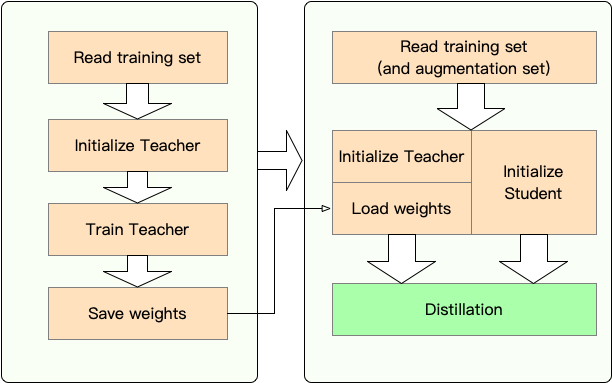TextBrewer is a PyTorch-based toolkit for distillation of NLP models. It includes various distilltion techniques from both NLP and CV, and provides an easy-to-use distillation framkework, which allows users to quickly experiment with state-of-the-art distillation methods to compress the model with a relatively small sacrifice in performance, increase the inference speed and reduce the memory usage.
Paper: https://arxiv.org/abs/2002.12620
Mar 2, 2020
- Current version: 0.1.7, the first public version.
| Section | Contents |
|---|---|
| Introduction | Introduction to TextBrewer |
| Installation | How to install |
| Workflow | Two stages of TextBrewer workflow |
| Quickstart | Example: distilling BERT-base to a 3-layer BERT |
| Experiments | Distillation experiments on typical English and Chinese datasets |
| Core Concepts | Brief explanations of the core concepts in TextBrewer |
| FAQ | Frequently asked questions |
| Citation | Citation to TextBrewer |
| Follow Us | - |
Textbrewer is designed for the knowledge distillation of NLP models. It provides various distillation methods and offers a distillation framework for quickly setting up experiments.
The main features of TextBrewer are:
- Wide-support: it supports various model architectures (especially transformer-based models)
- Flexibility: design your own distillation scheme by combining different techniques; it also supports user-defined loss functions, modules, etc.
- Easy-to-use: users don't need to modify the model architectures
- Built for NLP: it is suitable for a wide variety of NLP tasks: text classification, machine reading comprehension, sequence labeling, ...
TextBrewer currently is shipped with the following distillation techniques:
- Mixed soft-label and hard-label training
- Dynamic loss weight adjustment and temperature adjustment
- Various distillation loss functions: hidden states MSE, attention-matrix-based loss, neuron selectivity transfer, ...
- Freely adding intermediate features matching losses
- Multi-teacher distillation
- ...
TextBrewer includes:
- Distillers: the cores of distillation. Different distillers perform different distillation modes. There are GeneralDistiller, MultiTeacherDistiller, BasicTrainer, etc.
- Configurations and presets: Configuration classes for training and distillation, and predefined distillation loss functions and strategies.
- Utilities: auxiliary tools such as model parameters analysis.
To start distillation, users need to provide
- the models (the trained teacher model and the un-trained student model)
- datasets and experiment configurations
TextBrewer has achieved impressive results on several typical NLP tasks. See Experiments.
See API documentation for detailed usages.
-
Requirements
- Python >= 3.6
- PyTorch >= 1.1.0
- TensorboardX or Tensorboard
- NumPy
- Transformers >= 2.0 (optional, used by some examples)
-
Install from PyPI
pip install textbrewer
-
Install from the Github source
git clone https://github.com/airaria/TextBrewer.git pip install ./textbrewer
-
Stage 1: Preparation:
- Train the teacher model
- Define and intialize the student model
- Construct a dataloader, an optimizer and a learning rate scheduler
-
Stage 2: Distillation with TextBrewer:
- Construct a TraningConfig and a DistillationConfig, initialize a distiller
- Define an adaptor and a callback. The adaptor is used for adaptation of model inputs and outputs. The callback is called by the distiller during training
- Call the train method of the distiller
Here we show the usage of TextBrewer by distilling BERT-base to a 3-layer BERT.
Before distillation, we assume users have provided:
- A trained teacher model
teacher_model(BERT-base) and a to-be-trained student modelstudent_model(3-layer BERT). - a
dataloaderof the dataset, anoptimizerand a learning ratescheduler.
Distill with TextBrewer:
import textbrewer
from textbrewer import GeneralDistiller
from textbrewer import TrainingConfig, DistillationConfig
# Show the statistics of model parameters
print("\nteacher_model's parametrers:")
_ = textbrewer.utils.display_parameters(teacher_model,max_level=3)
print("student_model's parametrers:")
_ = textbrewer.utils.display_parameters(student_model,max_level=3)
# Define an adaptor for translating the model inputs and outputs
def simple_adaptor(batch, model_outputs):
# The second and third elements of model outputs are the logits and hidden states
return {'logits': model_outputs[1],
'hidden': model_outputs[2]}
# Training configuration
train_config = TrainingConfig()
# Distillation configuration
# Matching different layers of the student and the teacher
distill_config = DistillationConfig(
intermediate_matches=[
{'layer_T':0, 'layer_S':0, 'feature':'hidden', 'loss': 'hidden_mse','weight' : 1},
{'layer_T':8, 'layer_S':2, 'feature':'hidden', 'loss': 'hidden_mse','weight' : 1}])
# Build distiller
distiller = GeneralDistiller(
train_config=train_config, distill_config = distill_config,
model_T = teacher_model, model_S = student_model,
adaptor_T = simple_adaptor, adaptor_S = simple_adaptor)
# Start!
with distiller:
distiller.train(optimizer, scheduler, dataloader, num_epochs=1, callback=None)Examples can be found in the examples directory :
- examples/random_token_example : a simple runable toy example which demonstrates the usage of TextBrewer. This example performs distillation on the text classification task with random tokens as inputs.
- examples/cmrc2018_example (Chinese): distillation on CMRC2018, a Chinese MRC task, using DRCD as data augmentation.
- examples/mnli_example (English): distillation on MNLI, an English sentence-pair classification task. This example also shows how to perform multi-teacher distillation.
We have performed distillation experiments on several typical English and Chinese NLP datasets. The setups and configurations are listed below.
- For English tasks, the teacher model is BERT-base-cased.
- For Chinese tasks, the teacher model is RoBERTa-wwm-ext released by the Joint Laboratory of HIT and iFLYTEK Research.
We have tested different student models. To compare with public results, the student models are built with standard transformer blocks except BiGRU which is a single-layer bidirectional GRU. The architectures are listed below. Note that the number of parameters includes the embedding layer but does not include the output layer of the each specific task.
| Model | #Layers | Hidden_size | Feed-forward size | #Params | Relative size |
|---|---|---|---|---|---|
| BERT-base-cased | 12 | 768 | 3072 | 108M | 100% |
| RoBERTa-wwm-ext | 12 | 768 | 3072 | 108M | 100% |
| T6 | 6 | 768 | 3072 | 65M | 60% |
| T3 | 3 | 768 | 3072 | 44M | 41% |
| T3-small | 3 | 384 | 1536 | 17M | 16% |
| T4-Tiny | 4 | 312 | 1200 | 14M | 13% |
| BiGRU | - | 768 | - | 31M | 29% |
- T6 archtecture is the same as DistilBERT[1], BERT6-PKD[2], and BERT-of-Theseus[3].
- T4-tiny archtecture is the same as TinyBERT[4].
- T3 architecure is the same as BERT3-PKD[2].
distill_config = DistillationConfig(temperature = 8, intermediate_matches = matches)
# Others arguments take the default valuesmatches are differnt for different models:
| Model | matches |
|---|---|
| BiGRU | None |
| T6 | L6_hidden_mse + L6_hidden_smmd |
| T3 | L3_hidden_mse + L3_hidden_smmd |
| T3-small | L3n_hidden_mse + L3_hidden_smmd |
| T4-Tiny | L4t_hidden_mse + L4_hidden_smmd |
The definitions of matches are at exmaple/matches/matches.py.
We use GeneralDistiller in all the distillation experiments.
- Learning rate is 1e-4 (unless otherwise specified).
- We train all the models for 30~60 epochs.
We experiment on the following typical Enlgish datasets:
| Dataset | Task type | Metrics | #Train | #Dev | Note |
|---|---|---|---|---|---|
| MNLI | text classification | m/mm Acc | 393K | 20K | sentence-pair 3-class classification |
| SQuAD 1.1 | reading comprehension | EM/F1 | 88K | 11K | span-extraction machine reading comprehension |
| CoNLL-2003 | sequence labeling | F1 | 23K | 6K | named entity recognition |
We list the public results from DistilBERT, BERT-PKD, BERT-of-Theseus, TinyBERT and our results below for comparison.
Public results:
| Model (public) | MNLI | SQuAD | CoNLL-2003 |
|---|---|---|---|
| DistilBERT (T6) | 81.6 / 81.1 | 78.1 / 86.2 | - |
| BERT6-PKD (T6) | 81.5 / 81.0 | 77.1 / 85.3 | - |
| BERT-of-Theseus (T6) | 82.4/ 82.1 | - | - |
| BERT3-PKD (T3) | 76.7 / 76.3 | - | - |
| TinyBERT (T4-tiny) | 82.8 / 82.9 | 72.7 / 82.1 | - |
Our results:
| Model (ours) | MNLI | SQuAD | CoNLL-2003 |
|---|---|---|---|
| BERT-base-cased | 83.7 / 84.0 | 81.5 / 88.6 | 91.1 |
| BiGRU | - | - | 85.3 |
| T6 | 83.5 / 84.0 | 80.8 / 88.1 | 90.7 |
| T3 | 81.8 / 82.7 | 76.4 / 84.9 | 87.5 |
| T3-small | 81.3 / 81.7 | 72.3 / 81.4 | 57.4 |
| T4-tiny | 82.0 / 82.6 | 75.2 / 84.0 | 79.6 |
Note:
- The equivlent model architectures of public models are shown in the brackets.
- When distilling to T4-tiny, NewsQA is used for data augmentation on SQuAD and HotpotQA is used for data augmentation on CoNLL-2003.
We experiment on the following typical Chinese datasets:
| Dataset | Task type | Metrics | #Train | #Dev | Note |
|---|---|---|---|---|---|
| XNLI | text classification | Acc | 393K | 2.5K | Chinese translation version of MNLI |
| LCQMC | text classification | Acc | 239K | 8.8K | sentence-pair matching, binary classification |
| CMRC 2018 | reading comprehension | EM/F1 | 10K | 3.4K | span-extraction machine reading comprehension |
| DRCD | reading comprehension | EM/F1 | 27K | 3.5K | span-extraction machine reading comprehension (Traditional Chinese) |
The results are listed below.
| Model | XNLI | LCQMC | CMRC 2018 | DRCD |
|---|---|---|---|---|
| RoBERTa-wwm-ext | 79.9 | 89.4 | 68.8 / 86.4 | 86.5 / 92.5 |
| T3 | 78.4 | 89.0 | 66.4 / 84.2 | 78.2 / 86.4 |
| T3-small | 76.0 | 88.1 | 58.0 / 79.3 | 65.5 / 78.6 |
| T4-tiny | 76.2 | 88.4 | 61.8 / 81.8 | 73.3 / 83.5 |
Note:
- On CMRC2018 and DRCD, learning rates are 1.5e-4 and 7e-5 respectively and there is no learning rate decay.
- CMRC2018 and DRCD take each other as the augmentation dataset In the experiments.
TrainingConfig: configuration related to general deep learning model trainingDistillationConfig: configuration related to distillation methods
Distillers are in charge of conducting the actual experiments. The following distillers are available:
BasicDistiller: single-teacher single-task distillation, provides basic distillation strategies.GeneralDistiller(Recommended): single-teacher single-task distillation, supports intermediate features matching. Recommended most of the time.MultiTeacherDistiller: multi-teacher distillation, which distills multiple teacher models (of the same task) into a single student model. This class doesn't support Intermediate features matching.MultiTaskDistiller: multi-task distillation, which distills multiple teacher models (of different tasks) into a single student. This class doesn't support Intermediate features matching.BasicTrainer: Supervised training a single model on a labeled dataset, not for distillation. It can be used to train a teacher model.
In TextBrewer, there are two functions that should be implemented by users: callback and adaptor.
At each checkpoint, after saving the student model, the callback function will be called by the distiller. Callback can be used to evaluate the performance of the student model at each checkpoint.
It converts the model inputs and outputs to the specified format so that they could be recognized by the distiller, and distillation losses can be computed. At each training step, batch and model outputs will be passed to the adaptor; adaptor re-organize the data and returns a dictionary.
Fore more details, see the explanations in API documentation
TBA
If you find TextBrewer is helpful, please cite our paper:
@article{textbrewer,
title={TextBrewer: An Open-Source Knowledge Distillation Toolkit for Natural Language Processing},
author={Yang, Ziqing and Cui, Yiming and Chen, Zhipeng and Che, Wanxiang and Liu, Ting and Wang, Shijin and Hu, Guoping},
journal={arXiv preprint arXiv:2002.12620},
year={2020}
}
Follow our official WeChat account to keep updated with our latest technologies!

